Welcome to Roger Russell's
McIntosh Driver History—Midranges
Copyright
1996-2003 by Roger Russell
All rights reserved
No portion of this site may be reproduced in whole or in part
without written permission of the author.
|
002 8" mid |
027 1-1/2" dome mid |
055 1-1/2" dome mid |
![]()
8" Mid-Range 036-002
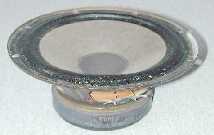 The
8" mid-range speakers were initially made by United Speaker Systems to my
specifications. The voice coil diameter is 1-1/2" and the ferrite magnet
is 25 oz. The surround is cloth coated with a sealant similar to Barrette's
edge dampening that never hardened. The cone is curvilinear in shape, meaning
that is not straight sided but curves slightly outward. A vented dust cap is
located in the center.
The
8" mid-range speakers were initially made by United Speaker Systems to my
specifications. The voice coil diameter is 1-1/2" and the ferrite magnet
is 25 oz. The surround is cloth coated with a sealant similar to Barrette's
edge dampening that never hardened. The cone is curvilinear in shape, meaning
that is not straight sided but curves slightly outward. A vented dust cap is
located in the center.
 Tinsel
Leads are brought out to a double terminal on one side of the basket. A red dot
is placed near the positive terminal to indicate polarity. The drivers are
stamped M-406. This is a manufacturing number assigned by United. The M
indicates a mid-range. They have a typical date of manufacture stamp such as
OCT 10 1975.
Tinsel
Leads are brought out to a double terminal on one side of the basket. A red dot
is placed near the positive terminal to indicate polarity. The drivers are
stamped M-406. This is a manufacturing number assigned by United. The M
indicates a mid-range. They have a typical date of manufacture stamp such as
OCT 10 1975.
![]()
This 8" mid-range replaces the 002. It's identical to but has a foam surround. The foam surround has smoother response than the cloth and doesn't pick up dust from the edge coating.
![]()
8" Mid-Range 036-025, 031, 058
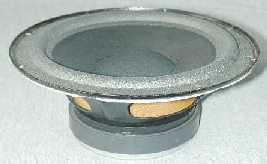 This later
version replaced the 018 mid. The magnet structure and basket is identical but
it has a straight-sided cone with a foam surround made by Donal. The response
was improved over the 018. The spider was also changed at this time. The
changes resulted in a slight decrease in efficiency. Service bulletins were
issued with instructions for replacing the 002 driver in the ML systems. This
involved decreasing the series resistor to the speaker. Several other versions
of the 8" speaker were made until the new cast baskets were introduced in
the 1990's.
This later
version replaced the 018 mid. The magnet structure and basket is identical but
it has a straight-sided cone with a foam surround made by Donal. The response
was improved over the 018. The spider was also changed at this time. The
changes resulted in a slight decrease in efficiency. Service bulletins were
issued with instructions for replacing the 002 driver in the ML systems. This
involved decreasing the series resistor to the speaker. Several other versions
of the 8" speaker were made until the new cast baskets were introduced in
the 1990's.
The 031 is the same as the 025 but was made by Rola-Jensen and required a new part number for the different manufacturer.
The 058 is also the same but was made by McIntosh and again required a new part number.
The efficiency of the 8" drivers was so high that various resistor L-pads were used to match the lower efficiency of the other drivers in the various systems. In all these years, I have never heard of an 8" driver that was overdriven and burned out. Although the ML systems had no fuse protection, the few failures in 8" output was due to crossover resistor burnout and not from driver damage.
![]()
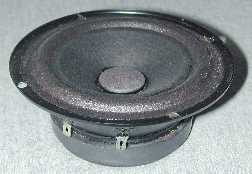 The 049
5" mid-range is made by McIntosh. It replaced the 036-048 That was made by
Rola-Jensen to my specifications. It has a sealed back. This allows it to be
used without a separate compartment to isolate the cone from being driven by a
woofer. Acoustic material is used between the cone and basket. A 9.5-oz magnet
and 3/16" thick front plate is used in the magnet assembly. The cone is
paper with an impregnated cloth half roll surround. The dust cap is paper. The
voice coil is 1" in diameter
The 049
5" mid-range is made by McIntosh. It replaced the 036-048 That was made by
Rola-Jensen to my specifications. It has a sealed back. This allows it to be
used without a separate compartment to isolate the cone from being driven by a
woofer. Acoustic material is used between the cone and basket. A 9.5-oz magnet
and 3/16" thick front plate is used in the magnet assembly. The cone is
paper with an impregnated cloth half roll surround. The dust cap is paper. The
voice coil is 1" in diameter
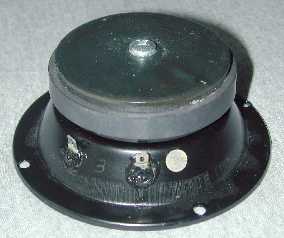 Two
terminals are mounted on the rear of the basket with insulating washers. A
white or red dot indicates positive polarity. The basket diameter is 5".
The magnet diameter is 3-3/8". Depth behind the mounting surface is
1-7/8". Weight is 3/4 lb.
Two
terminals are mounted on the rear of the basket with insulating washers. A
white or red dot indicates positive polarity. The basket diameter is 5".
The magnet diameter is 3-3/8". Depth behind the mounting surface is
1-7/8". Weight is 3/4 lb.
This speaker is used in the McIntosh XR3, XR14, XR1051, XR1052, XR250 and XR290 speaker systems
![]()
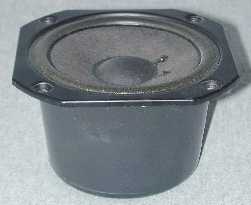 This 5"
mid-range is made by Cotron in Taiwan. The decorative mounting frame is part of
the stamped steel basket and is painted black. A plastic enclosure seals the
rear of the driver. The two leads are brought out at the rear of the enclosure.
This 5"
mid-range is made by Cotron in Taiwan. The decorative mounting frame is part of
the stamped steel basket and is painted black. A plastic enclosure seals the
rear of the driver. The two leads are brought out at the rear of the enclosure.
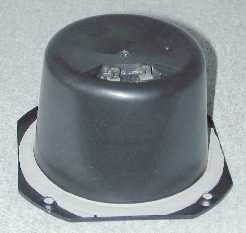 A red dot
on the terminal indicates polarity. The cone and dust cap are paper and the
surround is a urethane half roll. This mid-range is used in the XD715 and the
XR230.
A red dot
on the terminal indicates polarity. The cone and dust cap are paper and the
surround is a urethane half roll. This mid-range is used in the XD715 and the
XR230.
Foam mounting tape is attached to the basket of the mid-range before it is installed in the cabinet. This insures a good seal to the cabinet.
The outside of the basket is 5-5/8" across the diagonal. Depth behind the mounting surface is 2-7/8". Weight is 1.2 lbs.
![]()
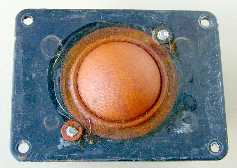 This soft
dome driver was made by United Speaker Systems in East Orange, NJ. The soft
dome originates with Bill Hecht who is the inventor and was president of United
Speaker Systems at that time. The patent number is 3,328,537 and was issued on
June 27, 1967. Bill improved the dome construction since the patent was issued
and these improvements are used in the 016 dome. The dome and surround is one
piece and made of phenolic impregnated cotton similar to that used for spiders.
Nuway Speaker Products in Chicago made them. They made spiders for many speaker
manufacturers at that time.
This soft
dome driver was made by United Speaker Systems in East Orange, NJ. The soft
dome originates with Bill Hecht who is the inventor and was president of United
Speaker Systems at that time. The patent number is 3,328,537 and was issued on
June 27, 1967. Bill improved the dome construction since the patent was issued
and these improvements are used in the 016 dome. The dome and surround is one
piece and made of phenolic impregnated cotton similar to that used for spiders.
Nuway Speaker Products in Chicago made them. They made spiders for many speaker
manufacturers at that time.
The two voice coil leads are brought out at the top through the edge of the surround on either side of the dome. They are routed to eyelets that go through the steel front plate. The eyelets are insulated by fiber shoulder washers. A slip-on connector terminal is fastened to each eyelet under the front plate. The red washer indicates the plus terminal.
A 1-1/2" diameter alnico magnet is centered in a U shaped magnet structure. The magnet is 1" high. A pole piece is attached directly to the top of the magnet. The U shaped structure is welded to a 3" X 4" front plate. Identification on the back is typically MT-150-1. United used this dome in non-McIntosh systems as a combination mid and tweeter so the designation is MT. The date stamp on the driver in the picture is MAR 22 1974.
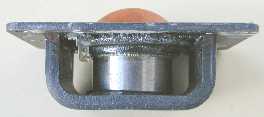 In
assembling the driver, a rubber sink type washer and a cup shaped paper gasket
are slid down on the magnet before gluing it into the magnet structure. Metal
shims are then slid up into place in the gap between the pole piece and the
front plate. A fiberglass pad is placed inside the hollow soft dome and the
dome/coil assembly is cemented in place. After drying, the shims are removed.
The paper gasket and washer are then slid up into place to form a small cavity
behind the voice coil. They are then coated with adhesive to give a complete
seal. The domes and surrounds are then treated by painting butyl rubber
dissolved in toluene to seal the holes or interstices in the cotton. The
speaker is then magnetized.
In
assembling the driver, a rubber sink type washer and a cup shaped paper gasket
are slid down on the magnet before gluing it into the magnet structure. Metal
shims are then slid up into place in the gap between the pole piece and the
front plate. A fiberglass pad is placed inside the hollow soft dome and the
dome/coil assembly is cemented in place. After drying, the shims are removed.
The paper gasket and washer are then slid up into place to form a small cavity
behind the voice coil. They are then coated with adhesive to give a complete
seal. The domes and surrounds are then treated by painting butyl rubber
dissolved in toluene to seal the holes or interstices in the cotton. The
speaker is then magnetized.
Reject rates were relatively high. Often, instead of demagnetizing the assemblies and completely rebuilding them from scratch, the old dome-coil assemblies were scraped off from the front plate. New dome sub-assemblies were put in blind, which means that no centering devices were used. The voice coils were "buzzed" into the correct centering. To do this, the voice coil is driven by a power amplifier connected to an oscillator. If the voice coil is rubbing, a buzzing sound could be heard. The dome/coil assembly is then shifted around until the buzzing stops. This has to be done before the adhesive dries. Hopefully, the dome is then well centered. Several other companies have used this method of centering.
The 016 1-1/2"dome drivers are used in the ML-1C, ML-2C, ML-2M, ML-4C and ML-4M. Although this driver was used as a combination mid/tweeter by United Speaker Systems for other customers, It did not radiate significantly out to 20kHz, particularly off axis. I added a tweeter to extend the response on and off axis. This driver is therefore considered be a mid-range.
A Comparison With the 035 Dome.

The green response curves are for two 016 domes that were made in 1973 by United. The red curves are for two 035 domes that were made in 1978 by McIntosh. The 035 dome is used in early McIntosh XR systems. Ideally, a speaker should have response only in the range intended for its use and then roll off without the use of any crossover network. Then, only minor elements are needed to supplement the rolloff. The response curves above were made without the use of any network. As you can see, the 035 response is inherently smoother than the 016. Very minor correction is needed compared to that needed for the 016.
The drivers are used in the range of 1.5 kHz to 7 kHz. . Because the 016 response varies widely at the frequency extremes, an entirely different network is needed to smooth out the response. Clearly, then, the drivers are not interchangeable using the same crossover network. Also, there is a 2-3 dB difference in response between the two 016's and very little difference between the two 035's. It indicates that the 035's are more uniform from driver to driver. The curves above were made in 2003, many years after these drivers were manufactured.
I should explain a little about the way we made response curves and how to interpret them. I'm using the same test equipment that I used back then. This consists of a General Radio 1564A Sound and Vibration Analyzer that is chain driven by a General Radio 1521B Graphic Level Recorder. The response is automatically plotted with a pen on chart paper. Random noise, called pink noise, is fed to the speaker. Pink noise is filtered white noise. White noise is constant energy per cycle. When filtered at the rate of minus 3 dB per decade, it becomes constant energy per octave (pink noise) and more closely approximates program material. The analyzer is a continuously variable 1/3-octave filter that sweeps the frequency range being tested. The small variations are the result of the random mature of the noise. I have used a slow averaging time to smooth the curves out. A slower averaging can be used and will smooth the curves even more. However, it takes a longer time to run the curves.
The analyzer runs from 2.5 Hz to 25 kHz in four sections of X1, X10, X100 and X1000. The gap at the center of the chart is where the analyzer switches from the section 250 Hz -2.5 kHz over to the last section of 2.5kHz to 25 kHz. The gap can be ignored. Yes, the equipment is antique by today's standards but is by no means obsolete.
![]()
The 036-017 dome used only in the ML-4C and ML-4M has almost identical construction, but has a wider surround and different resonant frequency than the 016. Instead of fiberglass behind the dome, a dome shaped piece of felt is used. This is solid white felt that is machined into shape.
![]()
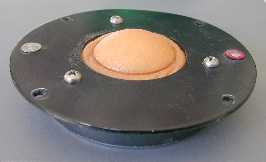 This
driver is also made by United Speaker Systems and is used only in the ML-10C
speaker system. The driver is mounted in the system with three screws. The
magnet structure includes a ferrite magnet.
This
driver is also made by United Speaker Systems and is used only in the ML-10C
speaker system. The driver is mounted in the system with three screws. The
magnet structure includes a ferrite magnet.
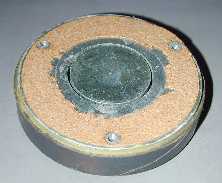 The
soft dome/voice coil assembly is mounted from the underside of a black anodized
aluminum plate 4-1/2" in diameter and 3/32" thick. This assembly is
then attached to the front plate of the magnet subassembly with three screws. A
thin piece of cork is used in between to prevent vibration between the two
pieces. Some of the cork came off with the plate in the right hand picture.
The
soft dome/voice coil assembly is mounted from the underside of a black anodized
aluminum plate 4-1/2" in diameter and 3/32" thick. This assembly is
then attached to the front plate of the magnet subassembly with three screws. A
thin piece of cork is used in between to prevent vibration between the two
pieces. Some of the cork came off with the plate in the right hand picture.
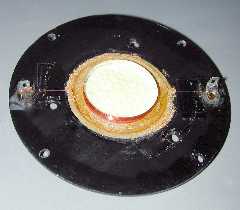 Here's a
view underneath the plate. Soft fiberglass called "Friendly
Fiberglass" is placed inside the dome. This helps to smooth the response.
The 1-1/2"voice coil is a reddish color. The voice coil form is glued
directly to the dome. The leads are dressed out at an angle across the roll
surround and to terminals on either side of the plate. The terminals are
insulated with fiber washers. A red fiber washer is used to indicate the
positive terminal.
Here's a
view underneath the plate. Soft fiberglass called "Friendly
Fiberglass" is placed inside the dome. This helps to smooth the response.
The 1-1/2"voice coil is a reddish color. The voice coil form is glued
directly to the dome. The leads are dressed out at an angle across the roll
surround and to terminals on either side of the plate. The terminals are
insulated with fiber washers. A red fiber washer is used to indicate the
positive terminal.
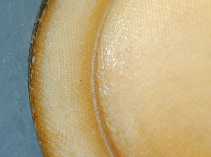 The
dome and half-roll surround are one piece and are made of the same phenolic
impregnated cotton cloth as the 016 and 017 domes. The interstices of the
cotton cloth are also sealed with butyl rubber dissolved in toluene.
The
dome and half-roll surround are one piece and are made of the same phenolic
impregnated cotton cloth as the 016 and 017 domes. The interstices of the
cotton cloth are also sealed with butyl rubber dissolved in toluene.
The surround is 3/32" wide, the same as the 017 dome. For this dome, the wide surround lowers resonance to about 800 Hz. When combined with the crossover network, response can be extended down 850 Hz to match the 10" woofer.
Size: 4-1/2" in diameter X 1-1/2" deep
Weight: 870 grams or about 1.9 lbs.
Impedance: 6.3 ohms
DCR: 5.6 ohms
Resonance 800 Hz
Although this driver was used as a combination mid/tweeter by United Speaker Systems for other customers, It does not radiate significantly out to 20kHz. I added a tweeter to extend the response. This driver is therefore considered be a mid-range.
![]()
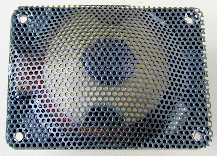 This is
the first driver manufactured by McIntosh. It is made differently from the 016
to enable McIntosh to manufacture a 1-1/2" dome speaker without infringing
on the 1967 Hecht soft dome patent.
This is
the first driver manufactured by McIntosh. It is made differently from the 016
to enable McIntosh to manufacture a 1-1/2" dome speaker without infringing
on the 1967 Hecht soft dome patent.
The surround and shoulder portion have the same phenolic impregnated cotton cloth as the 016 dome but the dome portion is cut out. A paper dome is substituted and glued to the shoulder instead. The half roll is coated with black sealer to close the interstices.
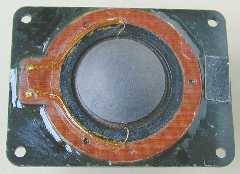 The dome
subassembly is separate from the magnet structure. It consists of a 1/8"
thick phenolic ring, dome, voice coil, surround, tinsel wires and terminals.
The tinsel leads are soldered to the voice coil wires at the kapton voice coil
form. The tinsel leads are dressed around opposite sides of the dome and out to
the terminals at the left side of the subassembly in the picture and glued in
place. They are inserted into two hollow pins mounted on the phenolic ring at
the left side and soldered. The pins pass through two holes in the front plate
of the magnetic structure. Slip-on connectors are later used to connect with
the internal wiring in the speaker systems.
The dome
subassembly is separate from the magnet structure. It consists of a 1/8"
thick phenolic ring, dome, voice coil, surround, tinsel wires and terminals.
The tinsel leads are soldered to the voice coil wires at the kapton voice coil
form. The tinsel leads are dressed around opposite sides of the dome and out to
the terminals at the left side of the subassembly in the picture and glued in
place. They are inserted into two hollow pins mounted on the phenolic ring at
the left side and soldered. The pins pass through two holes in the front plate
of the magnetic structure. Slip-on connectors are later used to connect with
the internal wiring in the speaker systems.
Three small holes in the phenolic ring locate on the three raised bumps in the magnet structure. These can be seen at the 11, 3 and 7 o'clock positions on the ring. By accurately locating the pins and the holes, any dome/ring subassembly can be mounted on any of the magnet structures and the voice coil is automatically centered in the gap. The ring is glued in place. The magnet structure was made by True Die and has a similar welded construction that was used in the 016 dome.
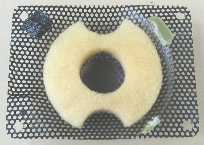 The
perforated cover serves several purposes. It protects the paper dome, but more
important, it holds the yellow fiberglass damping pad in place. This reduces
rim radiation and smoothes out the response. Two notches are cut in the washer
to allow the tinsel leads to loop over from the voice coil to the phenolic
ring. The cover also provides a surface to paste a black aluminum phasing disc
over the center of the dome. This reduces unwanted output that would otherwise
interfere with the tweeter. The cover was originally attached with three pieces
of double sided tape but later, epoxy was also used to hold the cover in place.
Epoxy and tape can be seen on this cover after it was removed.
The
perforated cover serves several purposes. It protects the paper dome, but more
important, it holds the yellow fiberglass damping pad in place. This reduces
rim radiation and smoothes out the response. Two notches are cut in the washer
to allow the tinsel leads to loop over from the voice coil to the phenolic
ring. The cover also provides a surface to paste a black aluminum phasing disc
over the center of the dome. This reduces unwanted output that would otherwise
interfere with the tweeter. The cover was originally attached with three pieces
of double sided tape but later, epoxy was also used to hold the cover in place.
Epoxy and tape can be seen on this cover after it was removed.
The epoxy keeps the cover from squeezing the phenolic ring a tiny amount when the driver is installed with screws in the four corners. Otherwise, the pressure may be enough to displace the phenolic ring and cause the voice coil to rub against the pole piece or front plate.
 A
1-1/2" diameter alnico magnet is centered in a U shaped magnet structure.
The magnet is 1" high. A pole piece is attached directly to the top of the
magnet. The U shaped structure is welded to a 3" X 4" front plate. A
small portion of the voice coil and orange colored Kapton form can be seen near
the top of the cylinder. The voice coil slightly overhangs the gap at the top
and bottom.
A
1-1/2" diameter alnico magnet is centered in a U shaped magnet structure.
The magnet is 1" high. A pole piece is attached directly to the top of the
magnet. The U shaped structure is welded to a 3" X 4" front plate. A
small portion of the voice coil and orange colored Kapton form can be seen near
the top of the cylinder. The voice coil slightly overhangs the gap at the top
and bottom.
 Steel
plates are glued to both sides of this structure to seal it. The chamber that
is formed provides a low resonant frequency for the dome. Two pieces of
"friendly" fiberglass are placed around the magnet and provide
acoustic damping in the chamber. The fiberglass is called "friendly"
because it is made of extremely fine strands that do not irritate the skin when
handling it.
Steel
plates are glued to both sides of this structure to seal it. The chamber that
is formed provides a low resonant frequency for the dome. Two pieces of
"friendly" fiberglass are placed around the magnet and provide
acoustic damping in the chamber. The fiberglass is called "friendly"
because it is made of extremely fine strands that do not irritate the skin when
handling it.
One of the reasons that the 016 mid failed was the use of the solid copper voice coil wire as a flexible lead from the voice coil. It was dressed in a loop and then out to the terminals. The wire fatigued after extended use and usually broke at the junction of the voice coil and the loop. In the 035 mid, multi-strand flexible tinsel wire is attached at the voice coil form and the tinsel is brought out in a loop. Lead breakage is much reduced.
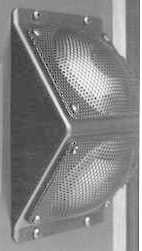 Although the
035 mid was designed and developed by engineering and production, a patent
number 3,956,599 was issued for a Dome Loudspeaker on May 11, 1976 to Frank H.
McIntosh. It completely describes the construction of the 036-035 dome
loudspeaker. It was not until 1997 that I learned of this.
Although the
035 mid was designed and developed by engineering and production, a patent
number 3,956,599 was issued for a Dome Loudspeaker on May 11, 1976 to Frank H.
McIntosh. It completely describes the construction of the 036-035 dome
loudspeaker. It was not until 1997 that I learned of this.
Size: 3" X 4" X 2" deep
Weight: 720 grams or about 1.6 lbs.
Impedance: 10 ohms
DCR: 9.5 ohms
Resonance: 1.3 kHz
A label on the back has the part number and date of manufacture. This driver is dated 7850 or the 50th week in 1978. The 035 is used in the XR-3, XR-5, XR-6 and XR-7 loudspeaker systems. A pair of these mids is used in the XR-7 system to increase the power handling. The drivers are angled to reduce interference and increase dispersion.
![]()
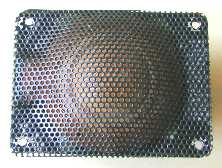 This
driver is designed and made by McIntosh. It is similar to the McIntosh 035 mid
but the response characteristics are designed to replace the 027 mid made by
United Speaker systems. The surround and dome are a single piece made of the
same phenolic impregnated cotton cloth as the 027 dome. The dome and surround
are painted with sealer to close the holes or interstices in the cotton. Unlike
the 035 mid, no front fiberglass damping or phasing disc is used. The surround
is wider than that used in the 035.
This
driver is designed and made by McIntosh. It is similar to the McIntosh 035 mid
but the response characteristics are designed to replace the 027 mid made by
United Speaker systems. The surround and dome are a single piece made of the
same phenolic impregnated cotton cloth as the 027 dome. The dome and surround
are painted with sealer to close the holes or interstices in the cotton. Unlike
the 035 mid, no front fiberglass damping or phasing disc is used. The surround
is wider than that used in the 035.
By the time these drivers went into production, many other companies, including Philips, were using soft dome drivers and ignoring the 1967 Hecht soft dome patent. Management decided to go ahead with an all soft dome construction.
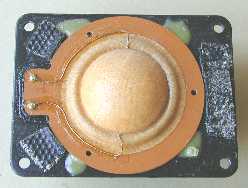 The dome
subassembly is separate from the magnet structure. It consists of a 1/8"
thick phenolic ring, dome, voice coil, surround, braided tinsel wires and
terminals. The tinsel leads are soldered to the voice coil wires at the Kapton
voice coil form. The tinsel leads are dressed around opposite sides of the dome
and out to the terminals at the left side of the subassembly in the picture and
glued in place. They are inserted into two hollow pins mounted on the phenolic
ring at the left side and soldered. The pins pass through two holes in the
front plate of the magnetic structure. Slip-on connectors are later used to
connect with the internal wiring in the speaker systems.
The dome
subassembly is separate from the magnet structure. It consists of a 1/8"
thick phenolic ring, dome, voice coil, surround, braided tinsel wires and
terminals. The tinsel leads are soldered to the voice coil wires at the Kapton
voice coil form. The tinsel leads are dressed around opposite sides of the dome
and out to the terminals at the left side of the subassembly in the picture and
glued in place. They are inserted into two hollow pins mounted on the phenolic
ring at the left side and soldered. The pins pass through two holes in the
front plate of the magnetic structure. Slip-on connectors are later used to
connect with the internal wiring in the speaker systems.
Three small holes in the phenolic ring locate on the three raised bumps in the magnet structure. These can be seen at the 11, 3 and 7 o'clock positions on the ring. By accurately locating the pins and the holes, any dome/ring subassembly can be mounted on any of the magnet structures and the voice coil is automatically centered in the gap. The ring is glued in place. The magnet structure is made by True Die and has a similar welded construction to that used in the 035 dome.
The perforated cover protects the dome. It is held in place with double-sided tape and then epoxy is added in four places. This keeps the cover from squeezing the phenolic ring a tiny amount when the dome is installed with screws in the four corners. Otherwise, the pressure may be enough to displace the phenolic ring and cause the voice coil to rub against the pole piece or front plate.
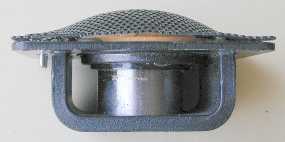 A 1-1/2"
diameter alnico magnet is centered in a U shaped magnet structure. The magnet
is 1" high. A pole piece is attached directly to the top of the magnet.
The U shaped structure is welded to a 3" X 4" front plate.
A 1-1/2"
diameter alnico magnet is centered in a U shaped magnet structure. The magnet
is 1" high. A pole piece is attached directly to the top of the magnet.
The U shaped structure is welded to a 3" X 4" front plate.
In assembling the driver, a rubber sink type washer and a cup shaped paper gasket are slid down on the magnet. A fiberglass pad is placed inside the hollow soft dome and the dome subassembly is then cemented in place. The paper gasket and washer are then slid up into place to form a small cavity behind the voice coil. They are coated with adhesive to give a complete seal. The speaker is then magnetized.
 One of
the reasons that the 027 mid failed was the use of the solid copper voice coil
wires as flexible leads from the voice coil. They were dressed in a loop and
then out to the terminals. The wire fatigued after extended use and usually
broke at the junction of the voice coil and the loop. In the 050 mid,
multi-strand flexible tinsel wire is attached at the voice coil form and the
tinsel leads are brought out in a loop. Lead breakage is much reduced.
One of
the reasons that the 027 mid failed was the use of the solid copper voice coil
wires as flexible leads from the voice coil. They were dressed in a loop and
then out to the terminals. The wire fatigued after extended use and usually
broke at the junction of the voice coil and the loop. In the 050 mid,
multi-strand flexible tinsel wire is attached at the voice coil form and the
tinsel leads are brought out in a loop. Lead breakage is much reduced.
Impedance: 6.8 ohms
DCR: 6.1 ohms
Resonance: 1.0 kHz
Size: 3" X 4" X 2" deep
Weight: 710 grams or about 1.6 lbs.
A label on the back has the part number and date of manufacture. This driver is dated 8105 or the 5th week in 1981. The 050 is used as a replacement in the ML-10C loudspeaker system. A black steel adapter plate is made by McIntosh to mount the 050 in place of the 027 driver. It measures 4-3/4" in diameter and 1/16" thick. Four screws hold the driver and plate to the cabinet. Foam gaskets are used in between the pieces to give a good seal.
![]()
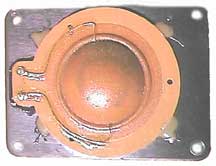 This driver
is designed and made by McIntosh. It is similar to the McIntosh 035 mid but the
response characteristics are designed to replace the 016 mid that was made by
United Speaker systems. The surround and dome are a single piece made of the
same phenolic impregnated cotton cloth as the 016 dome. The dome and surround
are painted with sealer to close the holes or interstices in the cotton. The
magnet, magnet structure and phenolic ring assembly are the same as the 035 but
no front fiberglass damping or phasing disc is used. The surround is narrow as
in the 016.
This driver
is designed and made by McIntosh. It is similar to the McIntosh 035 mid but the
response characteristics are designed to replace the 016 mid that was made by
United Speaker systems. The surround and dome are a single piece made of the
same phenolic impregnated cotton cloth as the 016 dome. The dome and surround
are painted with sealer to close the holes or interstices in the cotton. The
magnet, magnet structure and phenolic ring assembly are the same as the 035 but
no front fiberglass damping or phasing disc is used. The surround is narrow as
in the 016.
In assembling the driver, a rubber sink type washer and a cup shaped paper gasket are slid down on the magnet. A large and small fiberglass pad is placed inside the hollow soft dome and the dome subassembly is then cemented in place. The paper gasket and washer are then slid up into place to form a small cavity behind the voice coil. They are coated with adhesive to give a complete seal. The speaker is then magnetized.
One of the reasons that the 016 mid failed was the use of the solid copper voice coil wires as flexible leads from the voice coil. They were dressed in a loop and then out to the terminals. The wire fatigued after extended use and usually broke at the junction of the voice coil and the loop. In the 055 mid, multi-strand flexible tinsel wire is attached at the voice coil form and the tinsel leads are brought out in a loop. Lead breakage is much reduced.
A label on the back has the part number and date of manufacture. This driver is dated 8032 or the 32nd week in 1980. The 055 is used as a replacement in the ML-1C, ML-2C, ML2M, ML-4C and ML-4M loudspeaker systems. Four screws hold the driver in place.
![]()
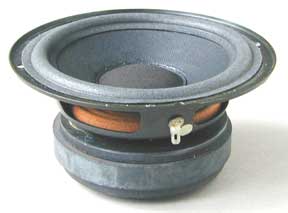 This
mid-range was designed and built by McIntosh. It was used in the XRT-18 system.
The magnet structure is very similar to the McIntosh made 063 woofer.
This
mid-range was designed and built by McIntosh. It was used in the XRT-18 system.
The magnet structure is very similar to the McIntosh made 063 woofer.
The voice coil leads are brought out to opposite sides of the cone to give good dynamic balance. the basket is 6-5/8" in diameter. It weighs 4.8 lbs.
![]()
|
|
|
About This Site |
|
|
More text and pictures about McIntosh will be added as my research continues. Any comments, corrections, or additions are welcome. |
|
|
|
|
Created by Roger Russell |